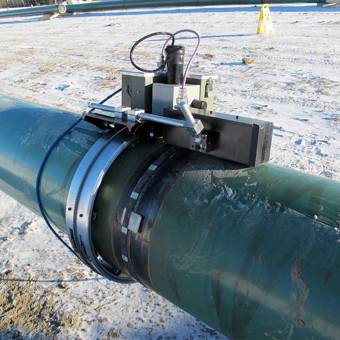Accuracy Issues: Relied On Pipeline Welding Inspection Providers for Critical Projects
Accuracy Issues: Relied On Pipeline Welding Inspection Providers for Critical Projects
Blog Article
Optimizing Effectiveness: Pipe Welding Assessment Best Practices
By applying best practices for pipeline welding assessment, companies can streamline processes, reduce mistakes, and improve task timelines. The thorough attention to detail required in welding evaluation holds the crucial to the lasting longevity and reliability of the pipelines, making it a subject of utmost relevance in the market.

Value of Reliable Welding Inspections
Effective welding assessments play a critical role in guaranteeing the structural stability and security of pipes. Appropriate assessments are essential to identify any defects, gaps, or flaws in the welded joints that might jeopardize the general integrity of the pipeline system. By conducting comprehensive evaluations, examiners can discover problems early, stopping prospective leaks, ruptures, or failings that can have severe ecological and security consequences.
Timely and exact welding evaluations also aid in keeping conformity with market standards and regulations. Sticking to these requirements is not only a lawful requirement yet likewise a required measure to assure the dependability and longevity of the pipes. Moreover, effective inspections can add to cost savings by decreasing the requirement for costly fixings or replacements due to welding issues that might have been prevented or remedied during the examination process.
Making Use Of Technology for Examinations
To improve the efficiency and precision of pipe welding assessments, the integration of innovative innovations has come to be progressively important in ensuring detailed and precise assessments of bonded joints. One of the essential technical developments in pipe welding evaluations is the usage of automated ultrasonic testing (AUT) systems. By welcoming these technological remedies, pipeline welding assessments can be conducted a lot more effectively, leading to greater quality welds, enhanced overall security, and reduced job timelines.
Developing Clear Evaluation Procedures
Developing clear evaluation procedures is essential for making sure uniformity and reliability in the pipeline welding assessment procedure. These protocols function as a set of guidelines that detail the particular actions, criteria, and approaches to be followed throughout evaluations. By plainly defining the evaluation procedures, all assessors associated with the process can understand their functions and obligations, leading to a more effective and standardized assessment process.

Normal testimonial and updates to the examination methods are additionally critical to adjust to transforming market requirements and demands. By continuously refining and improving the protocols based upon responses and lessons discovered, pipeline welding evaluations can support the finest criteria and regulative compliance.
Training and Certifications for Inspectors

Educating and accreditations for inspectors are extremely important in making sure the proficiency and proficiency of people charged with overseeing pipe welding processes - Pipeline Welding Inspection. Effectively trained inspectors have the required knowledge and abilities to effectively review weld high quality, adherence to welding treatments, and compliance with sector requirements and laws
Accreditations, such as those supplied by the American go to website Welding Society (AWS) or the American Oil Institute (API), verify an assessor's competence and ability to do inspections to the greatest standards. These accreditations often need strenuous training, examinations, and continuous specialist advancement to make sure that inspectors stay present with the most up to date improvements in welding modern technology and evaluation methods.
In enhancement to formal certifications, constant training programs play a critical role in improving assessors' capacities. These programs cover a wide variety of subjects, consisting of welding procedures, defect detection, security procedures, and appropriate codes and criteria (Pipeline Welding Inspection). By purchasing comprehensive training and certifications for examiners, companies can promote the honesty of their pipe try these out welding tasks and reduce the threats related to subpar welds
Continual Renovation in Inspection Procedures
Structure upon the structure of trained and certified inspectors, continual renovation in examination procedures is crucial for ensuring the recurring top quality and conformity of pipe welding operations. By executing a system of continuous improvement, pipe welding examination procedures can develop to meet the changing needs of the market, technological developments, and regulatory needs. This entails on a regular basis examining and evaluating examination techniques, treatments, and devices to identify locations for enhancement.
One trick element of continuous renovation in check these guys out evaluation procedures is comments. Gathering input from examiners, welders, engineers, and various other stakeholders allows for a thorough evaluation of existing methods and the recognition of prospective locations for enhancement. In addition, leveraging data and analytics can offer beneficial insights right into the effectiveness of examination processes, making it possible for informed decision-making for optimization.
Moreover, purchasing training and advancement programs for assessors can guarantee that they are furnished with the current understanding and abilities to perform their obligations efficiently. Constant renovation is a dynamic process that calls for dedication and commitment from all stakeholders to drive quality in pipe welding inspection practices.
Final Thought
Finally, making best use of performance in pipeline welding examinations is critical for making sure the quality and safety and security of facilities projects. By using technology, developing clear procedures, providing appropriate training and certifications for assessors, and continuously boosting evaluation procedures, organizations can simplify their operations and decrease risks. It is imperative for markets to focus on efficient welding examinations to maintain high criteria and meet governing requirements.
Effective inspections can contribute to set you back savings by lessening the demand for expensive fixings or replacements due to welding flaws that can have been avoided or remedied throughout the inspection process.
Developing clear inspection procedures is vital for ensuring consistency and dependability in the pipeline welding assessment procedure. By clearly specifying the inspection protocols, all assessors involved in the process can comprehend their duties and responsibilities, leading to a much more standard and reliable inspection workflow.
Clear evaluation procedures assist in minimizing the probability of mistakes or oversights throughout the examination procedure.Structure upon the structure of experienced and qualified assessors, continual renovation in examination procedures is crucial for ensuring the recurring top quality and conformity of pipe welding operations.
Report this page